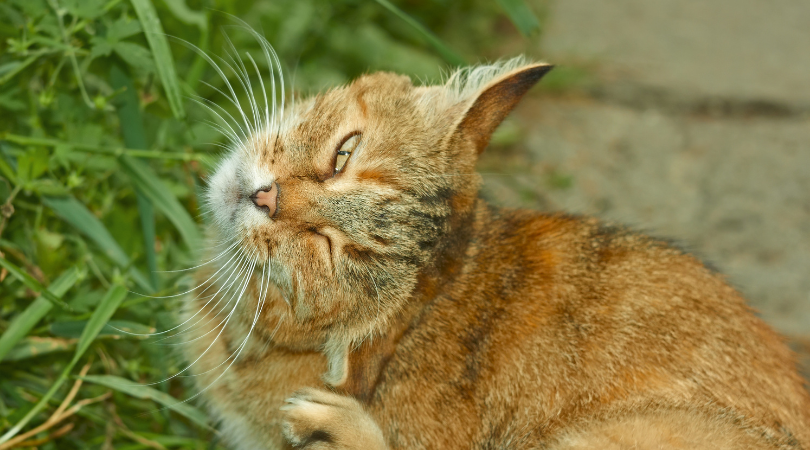Natural Flea Treatments for Cats: A Comprehensive Guide
Posted by Jewel on Mar 04, 2024
Cats, with their distinct personalities and habits, require special attention when it comes to flea treatment. Unlike dogs, cats have a low tolerance for essential oils, resist baths, and are not fans of most sprays. But fear not, cat guardians! There are natural, effective ways to keep your feline friends flea-free without causing them discomfort.
The Challenge with Cats and Fleas
Fleas are not just a nuisance; they can lead to health issues in cats, including dermatitis, tapeworms, and anemia. Traditional flea treatments often involve chemicals that can be harsh on your cat's sensitive skin or potentially toxic if ingested during grooming. Hence, natural solutions are not just preferable; they are a necessity for the wellbeing of your precious pets.
Diatomaceous Earth: The Frontline Defender
Food-grade Diatomaceous Earth (DE) is a non-toxic powder made from crushed fossils of freshwater organisms and marine life. Its microscopic sharp edges cut through the exoskeletons of fleas, dehydrating and killing them. While DE is effective, remember that it can be messy and cats might not be fond of being dusted. Combine DE with powdered herbs like neem and rosemary for enhanced effectiveness. Neem acts as a natural flea repellent, while rosemary helps soothe the skin.
Diatomaceous Earth (DE) offers a natural, non-toxic way to control fleas on cats. Made from the fossilized remains of tiny aquatic organisms called diatoms, DE works mechanically to eliminate fleas by piercing their exoskeletons, causing them to dehydrate and die. Here's how you can use it effectively:
- Choose Food-Grade DE: Ensure you're using food-grade Diatomaceous Earth, as it's safe for pets and humans.
- Application on Cats: Carefully dust your cat's fur with DE, avoiding the face and especially the eyes and nose. Massage it gently into their coat to ensure it reaches the skin. However, it's crucial to avoid over-application to prevent potential irritation. You can use a flea comb to comb the DE into the coat evenly.
- Environment Treatment: Fleas don’t just live on your cat; they inhabit your home environment as well. Dust DE on your cat’s bedding, carpet, and anywhere your cat frequents. Leave it for a couple of days before vacuuming to ensure that flea larvae and eggs are also targeted.
- Reapplication: Fleas have a life cycle that can extend beyond a few days, so it might be necessary to apply DE periodically, even daily at first to fully control the infestation. Repeat the application process as needed after the first few daily applications, generally about once a week for a few weeks.
- Safety Precautions: While DE is non-toxic, it can be drying to the skin and irritating if inhaled. Use a mask during application and try to keep your cat from inhaling the powder. After application, monitor your cat for any signs of respiratory distress or skin irritation.
Using Diatomaceous Earth for flea control in cats is an effective part of a holistic approach to flea management. It's most effective when combined with regular grooming, maintaining a clean environment, and a healthy diet for your pet.
Colloidal Silver For Helping to Prevent Fleas
In the quest for natural and safe flea control methods for our feline friends, colloidal silver emerges as a promising solution. The conventional flea treatments, laden with chemicals, pose significant health risks to both pets and their human companions. From skin irritations to severe neurological issues, the repercussions can be dire. Recognizing the need for a safer alternative, many pet owners have turned to colloidal silver, a natural antibiotic known for its broad-spectrum antimicrobial properties.
Remarkably, colloidal silver has shown efficacy not just as a preventive measure but also as a treatment for existing flea infestations. When added to pets' drinking water, or giving to them straight into a small bowl daily, colloidal silver can create an environment inhospitable to fleas without the adverse effects associated with chemical treatments. Testimonies from pet owners highlight the effectiveness of colloidal silver in helping to keep their cats flea-free, suggesting a simple yet effective method of flea control.
Moreover, colloidal silver's versatility extends beyond oral administration. Applying colloidal silver topically to your cat's coat can offer direct protection against fleas, acting as a natural repellent. This method is particularly beneficial for cats, who are notoriously sensitive to essential oils and conventional flea sprays.
It's important for pet owners to consider the overall well-being of their pets when choosing flea control methods. Colloidal silver presents a natural, non-toxic alternative that not only safeguards pets from fleas but also protects them from the potential harms of chemical treatments. As with any treatment, it's advisable to consult with a veterinarian before introducing colloidal silver or any new product into your pet's care regimen.
The use of colloidal silver for flea control in cats offers a safe, natural alternative to chemical-based products. By integrating colloidal silver into their pets' water bowls or applying it topically, pet owners can protect their beloved cats from fleas while avoiding the health risks associated with traditional flea treatments.
Brewer's Yeast: A Nutritional Flea Repellent
Adding brewer's yeast flakes to your cat's food can be a game-changer in flea prevention. Brewer's yeast is rich in Vitamin B, which, when ingested, emits a scent through the skin that fleas find unattractive. Alternatively, a B-1 (thiamine) supplement can serve the same purpose without altering your cat's diet significantly.
Hydrosols and Apple Cider Vinegar: Safe Topical Solutions
For those rare moments when your cat allows topical applications, opt for natural hydrosols or a diluted apple cider vinegar solution. Hydrosols, the byproduct water from essential oil production, offer a gentle fragrance along with flea-repellent properties. Apple cider vinegar, when diluted and applied via spray or sponge, can create an acidic environment on the skin that fleas avoid.
The Importance of Diet and Environment
Switching to a raw, specie appropriate diet can significantly reduce your cat's attractiveness to fleas. Fleas are drawn to cats on a high-carbohydrate kibble diet, so feeding raw meat can help make your cat's blood less appealing to these pests.
Household Flea Repellents
Using natural flea repellents like borax and salt can be an effective and less toxic way to control fleas in your home. Here’s how these substances work and other natural methods you can employ:
- Borax: sprinkling borax on carpets and around the house can kill flea larvae, helping to break the flea life cycle without using harsh chemicals. Borax is a natural mineral compound that can dehydrate and kill flea larvae and eggs, effectively breaking the flea life cycle. Sprinkle borax on carpets, under furniture, and in areas where pets rest or play. Let it sit for several hours (or overnight for best results) before vacuuming thoroughly. Be cautious and ensure pets and children do not ingest or come into direct contact with borax.
- Salt: Similar to borax, salt works by dehydrating fleas. Fine table salt can be evenly sprinkled over carpets and soft furnishings. Let it sit for a couple of days to affect flea eggs and larvae, then vacuum up. Salt is safer around pets but still should be used with caution to avoid ingestion in large amounts.
- Diatomaceous Earth (DE): Food-grade DE is another effective, natural flea control method. It's made from the fossilized remains of tiny aquatic organisms, and like borax and salt, it kills fleas by dehydrating them. Sprinkle DE in areas where fleas are suspected, let it sit, then vacuum. Ensure you’re using food-grade DE and not the kind meant for pool filtration systems.
- Natural Hydrosols: Hydrosols, the byproduct of essential oil production, can be used as a flea repellent spray. They're milder than essential oils and safer for use around cats. Lavender and chamomile hydrosols can soothe skin and repel fleas.
- Apple Cider Vinegar (ACV): A solution of ACV and water can be sprayed on pets’ coats and around the house as a flea deterrent. Although it won't kill fleas, it can repel them due to the vinegar's acidity.
- Regular Cleaning: Regular vacuuming, washing pet bedding in hot water, and steam cleaning carpets can significantly reduce flea infestations by removing fleas, eggs, and larvae from your environment.
- Environmental Control: Keeping your yard trimmed and free of debris can reduce outdoor flea habitats. Planting flea-repellent plants like lavender, mint, and lemongrass can also deter fleas from entering your yard.
It's important to approach flea control comprehensively, targeting both adult fleas and their larvae.
Herbal Repellents: Catnip and Lemongrass
Cats naturally love to roll in catnip, and fortunately, catnip acts as a fantastic flea repellent. Lemongrass, too, can repel insects when your cat interacts with it. Growing these herbs in your home or providing dried versions for your cat to play with can help keep fleas at bay naturally.
Conclusion
Protecting your cat from fleas doesn't have to involve harsh chemicals or stressful baths. With natural solutions like Diatomaceous Earth, brewer's yeast, hydrosols, and specific dietary changes, you can keep your feline friend happy, healthy, and flea-free. Remember, consistency is key, and integrating these practices into your daily routine will ensure the best protection for your pet.

